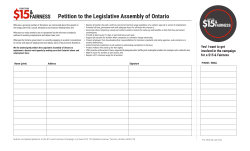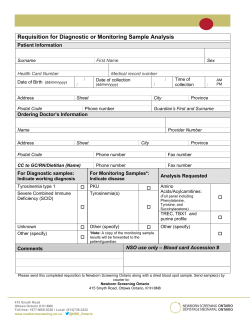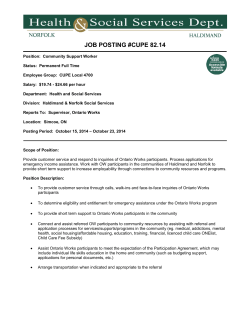
Running head: SENIOR HOUSING OPTIONS IN CANADA 1
Running head: SENIOR HOUSING OPTIONS IN CANADA Senior Housing Options in Canada Vanessa O. Rorai MSW student at Wayne State University Intern at Luella Hannan Memorial Foundation Thome Rivertown Neighborhood 1 SENIOR HOUSING OPTIONS IN CANADA 2 Senior Housing Options in Ontario Objective To identify senior housing options in the greater Windsor-Essex community and the province of Ontario, Canada. The following report discusses the types of senior housing available, how they are structured, financed, and the services/programs offered. Regulating or managing organizations will be also be identified per type of housing. Community Care Access Centre – CCAC The CCAC is a government-funded organization that connects individuals to care services based on their needs. CCAC coordinates services for seniors, people with disabilities and people who need health care services to help them live independently in the community (Ontario Ministry of Health and Long-Term Care , 2012). CCAC is funded by the Ministry of Health and Long-Term Care, which means that individuals do not pay directly for CCAC services because it is covered by the provincial health coverage. Provincial health coverage is paid through taxes. CCAC functions by region, the province of Ontario is divided into 14 regions. For the purposes of this report, the information from CCAC is obtained from the Erie St. Clair CCAC, which is the region Windsor is located within. CCAC performs two functions; assesses needs of client to determine which services they need to live in their current home, and assesses needs of client to determine which long-term care home is best-of-fit based on client needs. If CCAC determines a client can continue living in their home, they will provide whichever services the client needs from nurses to dieticians, speech therapists and more. Services Offered: Types of housing based on assessment of needs: • Assisted living • Supportive housing • Retirement homes • Short-stay care • Long-term care homes Community Care Services: • Meal delivery • Transportation • Homemaking and home help • Friendly visits • Day Programs available Home care services: • Nursing • Personal support • Physical Therapy • Social Work • Medical supplies, equipment The overarching organization is the Ontario Association of Community Care Access Centres, which is then divided into the specific CCAC regions (Ontario Association of Community Care Access Centres, n.d.). SENIOR HOUSING OPTIONS IN CANADA 3 Senior Apartments Senior apartments are designed for seniors who can live independently but who wish to live in a community designated for seniors and that may provide social or recreational programming. The individual unit may have an emergency call system but no regular care services are provided through management. Senior apartments are governed by the Residential Tenancies Act. Subsidies may be available through municipal or provincial governments. (Ontario Retirement Communities Association, n.d.) According to the Ontario Government Seniors Guide, apartments are referred to as Adult Lifestyle Communities. This guide suggests contacting local real estate agents to locate these communities (Ontario Senior’s Secretariat, 2014). The financing, structure, and management style of senior apartments are similar to typical apartment buildings, unless it is a non-profit housing (see below). The services offered varies between buildings, some offer 24-hour security, on-site recreational and leisure activities (Ontario Senior’s Secretariat, 2014). Non-Profit Housing Non-Profit housing is a type of affordable housing that is available in Ontario. It is also referred to as rent-geared-to-income (RGI) units. Of all non-profit housing in Ontario, 40% is only senior housing. Anyone can apply to live in non-profit housing, however, there are certain eligibility requirements the resident must meet to qualify for a subsidy. There are approximately 10-year waiting lists to live in non-profit housing across Ontario, thus to apply an individual can either contact a coordinated access center, or apply directly to the non-profit housing. Coordinated access centers are spread across Ontario to cover specific regions. The list of access centers can be obtained from the Ontario Non-Profit Housing Association website. Outside of subsidies and RGI units, there are no services or programs offered from non-profit housing, it is considered independent living. There are three main sources of revenue; tenant rents, government subsidies, and non-rental revenue (Ontario Non-Profit Housing Association, 2015). Although tenant rent is the main source of revenue, it doesn’t cover all operating costs, thus government subsidies makes up the difference. Non-rental revenue includes fees for parking, laundry, office space rentals, etc. According to the Ontario Non-Profit Housing Association (2015): “Most non-profits receive these subsidies from municipal governments through service managers. Some non-profit housing that was developed through federal programs still receive funding from the Government of Canada. This funding will end for all projects by 2032. Most supportive housing providers receive their subsidies from the provincial government through the Ministry of Health and Long-Term Care (MOHLTC) or the Ministry of Community and Social Services SENIOR HOUSING OPTIONS IN CANADA 4 (MCSS). Some housing providers also receive funding for support services for tenants who require help to live in their homes.” According to the Ontario Non-Profit Housing Association (2015): Types of non-profit housing are • Private non-profit housing - owned and managed by independent, community-based groups, such as faith groups and community agencies. • 89% of non-profit housing organizations are owned by community-based organization such as service clubs or faith groups. The rest are owned by municipalities. • Municipal non-profit housing providers - owned and operated by more than 100 different municipalities across Ontario. • Local housing corporations - owned and managed by service managers, the local government body responsible for housing, social welfare and ambulance services. Co-op housing The Co-operative Housing Federation of Canada defines co-op housing as notfor-profit housing in which the residents are members involved in operating the building. Some co-ops pay a reduced monthly rent geared to their income, some pay full monthly rent based on costs, and some co-ops utilize government funds to help pay rent. Each coop in Canada is a legal association, incorporated as a co-operative (The Co-operative Housing Federation of Canada, 2011). The Canada Mortgage and Housing Corporation provides all bylaws and regulations of co-ops in Ontario (Canada Mortgage and Housing Corporation, 2015). Services offered pertain to member’s rights and responsibilities as outlined by the Co-operative Housing Federation of Canada: Vote on the annual budget, which sets the monthly housing charges and affects the quality of your housing – for example, how much the co-op will spend on property upkeep Elect a board of directors made up of people who live in your co-op Run for the board of directors yourself Receive audited financial statements that show how the co-op spent your money Pay only a limited portion of your income for your housing, if you meet eligibility rules Live there for as long as you like, if you keep to the by-laws agreed on by the co-op membership The Co-operative Housing Federation of Canada divides Ontario into five regions: Eastern Ontario, Toronto/York Region, Central Ontario, Hamilton/Niagara, and Peel/Halton. There are no co-op housings in the Windsor area. Each co-op has their own application process: Residents must contact the specific co-op to determine what the process is. SENIOR HOUSING OPTIONS IN CANADA 5 The Co-operative Housing Federation of Canada formed an Aging in Place Committee in 2010 and published a survey in 2011 of aging co-op members’ needs as identified by aging members and co-op managers (The Co-operative Housing Federation of Canada, 2011). Two important key findings from the survey were that most members and housing co-ops have not made plans regarding aging members, and there is a shortage of accessible units for older members. The Aging in Place Committee determined three courses of action: Advocacy for better public policy initiatives, increase co-op governance awareness of older member’s needs, and promote planning tools for to support affordability and accessibility of aging members (The Co-operative Housing Federation of Canada, 2011). Retirement Homes According to the Ontario Government Seniors Guide from the Ontario Senior’s Secretariat (2014): Retirement homes are private businesses that sell various combinations of accommodations (from shared rooms to large apartments), support services and personal care. Anyone can apply to live in a retirement home. Residents are responsible for the entire cost of accommodation and care services. Accommodation rates are subject to rent control. Residences and rates can vary widely in terms of care, services and amenities provided. The retirement home will assess the individual’s needs to ensure the retirement home can provide needed supports. Retirement homes in Ontario are regulated under the Retirement Homes Act, 2010. This is enforced by the Retirement Homes Regulatory Authority (RHRA). According to the Retirement Homes Regulatory Authority (2015): The RHRA issues licenses based on inspections to retirement homes and provides a public registry of retirement homes and their current license status Retirement homes are required to pay licensing fees to maintain license of $9.22 per unit a month plus HST (harmonized sales tax, which is 13% in Ontario) Retirement homes do not receive any government funding (Retirement Homes Regulatory Authority, 2015). As stated above, services offered vary between retirement homes. I personally toured two retirement homes in the Windsor area to compare and contrast the services, structures, and fees for residents. The first retirement home is Amica, located in Windsor, ON. Amica provides all meals, activities, and outings at no extra cost to the residents. Amica will deliver resident’s medications to their room but if resident requires assistance taking their medication they must pay a service fee (such as eye drops, wound care, etc). Amica has a higher level of care floor for residents that may fall ill or require extra care, however, there is an extra charge per day a resident stays on this floor. SENIOR HOUSING OPTIONS IN CANADA 6 The second retirement home is Seasons Royal Oak, located in Lasalle, ON. This retirement home is similar to Amica however they provide more medical treatments at no cost (such has administering eye drops, medications, and wound care). Residents in need of help with bathing are given personal support care once a week at no charge. Seasons has a memory care unit for residents that need higher level of care. If a resident needs to be moved to the care unit there is no change in rent or extra fees. These are the main differences between the two facilities. Both are considered retirement homes because they do not receive any government funding, yet there are many differences in provided services. Furthermore, residents are able to obtain services from CCAC in their retirement home to meet any needs the retirement home cannot provide. For example, a resident at Seasons Royal Oak could have CCAC come into their home three or four times a week to help with bathing, physical therapy, or medical treatments, and still receive the personal support care from Seasons. Thus, a resident can tailor his or her own services within retirement homes based on the services they obtain through outside agencies. Supportive Housing “Designed for people who require minimal-to-moderate levels of personal care in order to live independently within an apartment-like setting. Accommodations, on-site services, costs, and the availability of geared-to-income government subsidies vary with each building. It is very common to find a waiting list. To qualify, you must be eligible for Community Care Access Centre (CCAC) home support services” (Ontario Retirement Communities Association, n.d.). “Supportive housing buildings are owned and operated by not-for-profit corporations such as municipal governments, housing cooperatives, or non-profit groups including faith groups, seniors' organizations, service clubs, cultural groups, and service providers. In most cases, the rent charged is based on ability to pay, or the market level rent is subsidized through the Ministry of Housing” (Community Care Access Centre, 2013). Living arrangements may include specially designed buildings, or a cluster of adapted apartments within an ordinary apartment building, shared houses or apartments and self-contained apartments (Community Care Access Centre, 2013). The Ministry of Health and Long-Term Care oversee management, and on-site personal support is provided with 24-hour staff (Community Care Access Centre, 2013). Access to supportive housing is through CCAC, must contact the CCAC in specific region to obtain list of supportive housing in that area. Long-Term Care Homes According to the government of Ontario website, long-term care homes provide 24-hour nursing and personal care to individuals who can no longer live independently. SENIOR HOUSING OPTIONS IN CANADA 7 Residents receive more care than in a retirement home or supportive housing (Government of Ontario, 2014). Long-term care homes (nursing homes), are funded by the provincial government. They are regulated by the Ministry of Health and Long-Term Care and governed by legislated standards under the Long-Term Care Homes Act, 2007 (Retirement Homes Regulatory Authority, 2015). The Ministry of Health and Long-Term Care sets out the accommodation fees for all long-term care homes. According to the Government of Ontario (2014), the current maximum rates are: Type of accommodation Long-stay Basic Long-stay Semi-private Long-stay Private Short-stay Daily rate $56.93 $67.93 (Basic plus a maximum of $11.00) $80.18 (Basic plus a maximum of $21.50) $36.85 Monthly rate $1,731.62 $2,066.21 $2,438.81 N/A Residents who cannot afford these rates can apply for a government subsidy. Subsidies are only available to basic rooms, and not available for semi-private and private rooms (Government of Ontario, 2014). These are the following eligibility requirements to live in a long-term care home according to the Government of Ontario (2014): Be age 18 or older Have a valid Ontario Health Insurance Program (OHIP) card Have care needs including: o 24-hours nursing care and personal care o Frequent assistance with activities of daily living o On-site supervision or monitoring to ensure your safety or well-being o Have care needs which cannot be safely met in the community though publicly-funded community-based services and other care-giving support o Have care needs which can be met in a long-term care home An individual must contact their local CCAC to start the application process. CCAC will determine eligibility and the available long-term care homes in the area. Once an individual is eligible they can apply to a maximum of five homes through CCAC (Government of Ontario, 2014). According to the Government of Ontario (2014) the following services and facilities are available at long-term care homes: Shared dining room, TV rooms and other living areas Nursing and personal care on a 24-hour basis Access to health professionals Individual care plan (reviewed every 3 months) Furnishings (e.g., bed and chair) Meals (including special diets) SENIOR HOUSING OPTIONS IN CANADA 8 Bed linens and laundry Personal hygiene supplies Medical/clinical supplies (e.g., walkers and wheelchairs for occasional use) Housekeeping Individualized religious and spiritual services Social and recreational programs Medical services Assistance with activities of daily living There are currently 20 long term care homes located in Windsor Essex County as listed by eriestclairhealthline.ca (2015) which gives up to date listings of health services in Ontario. Conclusion All senior housing options in Ontario Canada qualify for government subsidies to help pay rent, except senior apartments and retirement homes. The Community Care Access Centre is the only way to access supportive housing and long-term care homes. CCAC is also a helpful resource for connecting older adults to services within their home or to determine the best type of housing to meet their needs. The six types of housing for seniors discussed in this report focused on the Greater Windsor-Essex County region and the province of Ontario, Canada. SENIOR HOUSING OPTIONS IN CANADA 9 References Canada Mortgage and Housing Corporation. (2015). Guide to Co-operative Housing – Ontario. Retrieved from Canada Mortgage and Housing Corporation website: http://www.cmhc-schl.gc.ca/en/co/buho/gucoho/fash/fash_009.cfm Community Care Access Centre. (2013). Supportive Housing. Retrieved from Erie St. Clair CCAC website: http://healthcareathome.ca/eriestclair/en/Getting Care/Getting-Supported-Living/Supportive-Housing ErieStClairhealthline.ca. (2015). Long-Term Care Homes - Windsor-Essex . Retrieved February 9, 2015, from ErieStClairhealthline.ca website: http://www.eriestclairhealthline.ca/listServicesDetailed.aspx?id=10665 ®ion=WindsorEssex Government of Ontario. (2014). Long-term Care Homes. Retrieved from http://www.ontario.ca/health-and-wellness/find-long-term-care-home Ontario Association of Community Care Access Centres. (n. d.). Who We Are. Retrieved February 10, 2015, from oaccac: http://oaccac.com/Who-We-Are Ontario Ministry of Health and Long-Term Care . (2012, August 20). Community Care Access Centres. Retrieved March 3, 2015, from Ontario Ministry of Health Long-Term Care: http://www.health.gov.on.ca/en/public/contact/ccac/ Ontario Non-Profit Housing Association. (2015). About Non-profit housing . Retrieved January 20, 2015, from Ontario Non-Profit Housing Association: http://www.onpha.on.ca/onpha/web/Non-profit_housing/Content/About_Non Profit_Housing/About_non-profit_housing_tabs/About_Non Profit_Housing.aspx?hkey=8d6f6983-ea85-48c7-a3db-b2ad85e9be01 SENIOR HOUSING OPTIONS IN CANADA 10 Ontario Retirement Communities Association. (n.d.). Senior Living Options. Retrieved January 20, 2015, from ORCA: Ontario Retirement Communities Association: http://www.orcaretirement.com/retirement-living/seniors-living-options/ Ontario Senior’s Secretariat (2014). A guide to programs and services for seniors in Ontario (Service Ontario Publications). Retrieved from http://www.seniors.gov.on.ca/en/resources/seniorsguide/English.pdf Retirement Homes Regulatory Authority. (2015, February). Public Register. Retrieved January 20, 2015, from Retirement Homes Regulatory Authority: http://www.rhra.ca/en/register The Co-operative Housing Federation of Canada. (2011, April). Aging in Our Co-op Communities. Retrieved March 3, 2015, from The Co-operative Housing Foundation of Canada: http://www.chfcanada.coop/eng/pdf/CH%20Aging%20 in%20Place%20Report_E.pdf
© Copyright 2025









